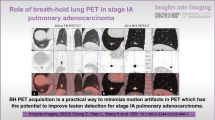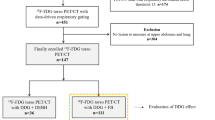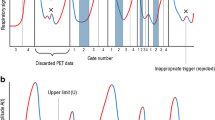Abstract
Objective
The objective of this study was to define the factors that correlate with differences in maximum standardized uptake value (SUVmax) in deep-inspiration breath-hold (DIBH) and free breathing (FB) PET/CT admixed with respiratory gating (RG) PET for reference.
Methods
Patients (n = 95) with pulmonary lesions were evaluated at one facility over 33 months. After undergoing whole-body PET/CT, a RG PET and FB PET/CT scans were obtained, followed by a DIBH PET/CT scan. All scans were recorded using a list-mode dynamic collection method with respiratory gating. The RG PET was reconstructed using phase gating without attenuation correction; the FB PET was reconstructed from the RG PET sinogram datasets with attenuation correction. Respiratory motion distance, breathing cycle speed, and waveform of RG PET were recorded. The SUVmax of FB PET/CT and DIBH PET/CT were recorded: the percent difference in SUVmax between the FB and DIBH scans was defined as the %BH-index.
Results
The %BH-index was significantly higher for lesions in the lower lung area than in the upper lung area. Respiratory motion distance was significantly higher in the lower lung area than in the upper lung area. A significant relationship was observed between the %BH-index and respiratory motion distance. Waveforms without steady end-expiration tended to show a high %BH-index. Significant inverse relationships were observed between %BH-index and cycle speed, and between respiratory motion distance and cycle speed.
Conclusion
Decrease in SUVmax of FB PET/CT was due to (1) tumor size, (2) distribution of lower lung, (3) long respiratory movement at slow breathing cycle speeds, and (4) respiratory waveforms without steady end-expiration.






Similar content being viewed by others
References
Kawano T, Ohtake E, Inoue T. Deep-inspiration breath-hold PET/CT of lung cancer: maximum standardized uptake value analysis of 108 patients. J Nucl Med. 2008;49:1223–31.
Nehmeh SA, Erdi YE, Ling CC, Rosenzweig KE, Schoder H, Larson SM, et al. Effect of respiratory gating on quantifying PET images of lung cancer. J Nucl Med. 2002;43:876–81.
Nehmeh SA, Erdi YE, Rosenzweig KE, Schoder H, Larson SM, Squire OD, et al. Reduction of respiratory motion artifacts in PET imaging of lung cancer by respiratory correlated dynamic PET: methodology and comparison with respiratory gated PET. J Nucl Med. 2003;44:1644–8.
Nehmeh SA, Erdi YE, Pan T, Yorke E, Mageras GS, Rosenzweig KE, et al. Quantitation of respiratory motion during 4D-PET/CT acquisition. Med Phys. 2004;31:1333–8.
Nehmeh SA, Erdi YE, Pan T, Pevsner A, Rosenzweig KE, Yorke E, et al. Four-dimensional (4D) PET/CT imaging of the thorax. Med Phys. 2004;31:3179–86.
Boucher L, Rodrigue S, Lecomte R, Bénard F. Respiratory gating for 3-dimensional PET of the thorax: feasibility and initial results. J Nucl Med. 2004;45:214–9.
El Naqa I, Low DA, Bradley JD, Vicic M, Deasy JO. Deblurring of breathing motion artifacts in thoracic PET images by deconvolution methods. Med Phys. 2006;33:3587–600.
Dawood M, Lang N, Jiang X, Schäfers KP. Lung motion correction on respiratory gated 3-D PET/CT images. IEEE Trans Med Imaging. 2006;25:476–85.
Dawood M, Büther F, Lang N, Schober O, Schäfers KP. Respiratory gating in positron emission tomography: a quantitative comparison of different gating schemes. Med Phys. 2007;34:3067–76.
Lamare F, Cresson T, Savean J, Cheze Le Rest C, Reader AJ, Visvikis D. Respiratory motion correction for PET oncology applications using affine transformation of list mode data. Phys Med Biol. 2007;52:121–40.
Hamill JJ, Bosmans G, Dekker A. Respiratory-gated CT as a tool for the simulation of breathing artifacts in PET and PET/CT. Med Phys. 2008;35:576–85.
Fin L, Daouk J, Morvan J, Bailly P, El Esper I, Saidi L, et al. Initial clinical results for breath-hold CT-based processing of respiratory-gated PET acquisitions. Eur J Nucl Med Mol Imaging. 2008;35:1971–80.
Bundschuh RA, Martínez-Möller A, Essler M, Nekolla SG, Ziegler SI, Schwaiger M. Local motion correction for lung tumours in PET/CT—first results. Eur J Nucl Med Mol Imaging. 2008;35:1981–8.
Lupi A, Zaroccolo M, Salgarello M, Malfatti V, Zanco P. The effect of 18F-FDG-PET/CT respiratory gating on detected metabolic activity in lung lesions. Ann Nucl Med. 2009;23:191–6.
Daouk J, Fin L, Bailly P, Meyer ME. Respiratory-gated positron emission tomography and breath-hold computed tomography coupling to reduce the influence of respiratory motion: methodology and feasibility. Acta Radiol. 2009;50:144–55.
Grotus N, Reader AJ, Stute S, Rosenwald JC, Giraud P, Buvat I. Fully 4D list-mode reconstruction applied to respiratory-gated PET scans. Phys Med Biol. 2009;54:1705–21.
Schleyer PJ, O’Doherty MJ, Barrington SF, Marsden PK. Retrospective data-driven respiratory gating for PET/CT. Phys Med Biol. 2009;54:1935–50.
Büther F, Dawood M, Stegger L, Wübbeling F, Schäfers M, Schober O, et al. List mode-driven cardiac and respiratory gating in PET. J Nucl Med. 2009;50:674–81.
Werner MK, Parker JA, Kolodny GM, English JR, Palmer MR. Respiratory gating enhances imaging of pulmonary nodules and measurement of tracer uptake in FDG PET/CT. Am J Roentgenol. 2009;193:1640–5.
Chang G, Chang T, Pan T, Clark JW Jr, Mawlawi OR. Implementation of an automated respiratory amplitude gating technique for PET/CT: clinical evaluation. J Nucl Med. 2010;51:16–24.
Nehmeh SA, Erdi YE, Meirelles GS, Squire O, Larson SM, Humm JL, et al. Deep-inspiration breath-hold PET/CT of the thorax. J Nucl Med. 2007;48:22–6.
Meirelles GS, Erdi YE, Nehmeh SA, Squire OD, Larson SM, Humm JL, et al. Deep-inspiration breath-hold PET/CT: clinical findings with a new technique for detection and characterization of thoracic lesions. J Nucl Med. 2007;48:712–9.
Daisaki H, Shinohara H, Terauchi T, Murano T, Shimada N, Moriyama N, et al. Multi-bed-position acquisition technique for deep inspiration breath-hold PET/CT: a preliminary result for pulmonary lesions. Ann Nucl Med. 2010;24:179–88.
Torizuka T, Tanizaki Y, Kanno T, Futatsubashi M, Yoshikawa E, Okada H, et al. Single 20-second acquisition of deep-inspiration breath-hold PET/CT: clinical feasibility for lung cancer. J Nucl Med. 2009;50:1579–84.
Yamaguchi T, Ueda O, Hara H, Sakai H, Kida T, Suzuki K, et al. Usefulness of a breath-holding acquisition method in PET/CT for pulmonary lesions. Ann Nucl Med. 2009;23:65–71.
Nagamachi S, Wakamatsu H, Kiyohara S, Fujita S, Futami S, Arita H, et al. The reproducibility of deep-inspiration breath-hold (18)F-FDG PET/CT technique in diagnosing various cancers affected by respiratory motion. Ann Nucl Med. 2010;24:171–8.
Acknowledgments
We thank Kazuyoshi Ootsu and Ai Takahashi for image analysis. This work was supported in part by Kanagawa Prefectural Hospitals Cancer Fund.
Conflict of interest
We have no conflict of interest.
Author information
Authors and Affiliations
Corresponding author
Electronic supplementary material
Electronic Supplementary Materials 1, 2 Movie files of Respiratory Gating PET; anterior view (ESM1.mpg), and lateral view (ESM2.mpg).
Supplementary material 1 (MPG 1786 kb)
Supplementary material 2 (MPG 1786 kb)
Rights and permissions
About this article
Cite this article
Kawano, T., Ohtake, E. & Inoue, T. Deep-inspiration breath-hold PET/CT versus free breathing PET/CT and respiratory gating PET for reference: evaluation in 95 patients with lung cancer. Ann Nucl Med 25, 109–116 (2011). https://doi.org/10.1007/s12149-010-0442-2
Received:
Accepted:
Published:
Issue Date:
DOI: https://doi.org/10.1007/s12149-010-0442-2




